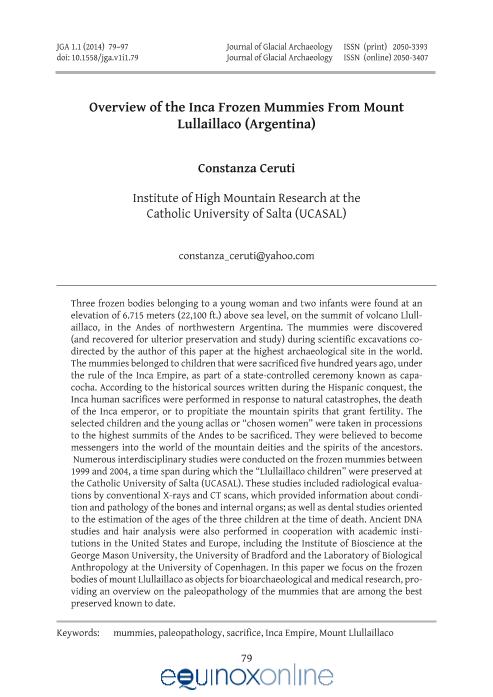Mostrar el registro sencillo del ítem
dc.contributor.author
Ceruti, Maria Constanza

dc.date.available
2017-02-02T20:39:50Z
dc.date.issued
2014-01
dc.identifier.citation
Ceruti, Maria Constanza; Overview of the Inca frozen mummies from Mount Lullaillaco (Argentina); Equinox Publishing; Journal of Glacial Archaeology; 1; 1; 1-2014; 79-97
dc.identifier.issn
2050-3393
dc.identifier.uri
http://hdl.handle.net/11336/12384
dc.description.abstract
Three frozen bodies belonging to a young woman and two infants were found at an elevation of 6.715 meters (22,100 ft.) above sea level, on the summit of volcano Llullaillaco, in the Andes of northwestern Argentina. The mummies were discovered (and recovered for ulterior preservation and study) during scientific excavations codirected by the author of this paper at the highest archaeological site in the world. The mummies belonged to children that were sacrificed five hundred years ago, under the rule of the Inca Empire, as part of a state-controlled ceremony known as capacocha. According to the historical sources written during the Hispanic conquest, the Inca human sacrifices were performed in response to natural catastrophes, the death of the Inca emperor, or to propitiate the mountain spirits that grant fertility. The selected children and the young acllas or “chosen women” were taken in processions to the highest summits of the Andes to be sacrificed. They were believed to become messengers into the world of the mountain deities and the spirits of the ancestors. Numerous interdisciplinary studies were conducted on the frozen mummies between 1999 and 2004, a time span during which the “Llullaillaco children” were preserved at the Catholic University of Salta (UCASAL). These studies included radiological evaluations by conventional X-rays and CT scans, which provided information about condition and pathology of the bones and internal organs; as well as dental studies oriented to the estimation of the ages of the three children at the time of death. Ancient DNA studies and hair analysis were also performed in cooperation with academic institutions in the United States and Europe, including the Institute of Bioscience at the George Mason University, the University of Bradford and the Laboratory of Biological Anthropology at the University of Copenhagen. In this paper we focus on the frozen bodies of mount Llullaillaco as objects for bioarchaeological and medical research, providing an overview on the paleopathology of the mummies that are among the best preserved known to date.
dc.format
application/pdf
dc.language.iso
eng
dc.publisher
Equinox Publishing
dc.rights
info:eu-repo/semantics/openAccess
dc.rights.uri
https://creativecommons.org/licenses/by-nc-sa/2.5/ar/
dc.subject
Mummies
dc.subject
Paleopathology
dc.subject
Sacrifice
dc.subject
Inca Empire
dc.subject
Mount Llullaillaco
dc.subject.classification
Otras Historia y Arqueología

dc.subject.classification
Historia y Arqueología

dc.subject.classification
HUMANIDADES

dc.title
Overview of the Inca frozen mummies from Mount Lullaillaco (Argentina)
dc.type
info:eu-repo/semantics/article
dc.type
info:ar-repo/semantics/artículo
dc.type
info:eu-repo/semantics/publishedVersion
dc.date.updated
2017-01-31T18:22:14Z
dc.identifier.eissn
2050-3407
dc.journal.volume
1
dc.journal.number
1
dc.journal.pagination
79-97
dc.journal.pais
Reino Unido

dc.journal.ciudad
Sheffield
dc.description.fil
Fil: Ceruti, Maria Constanza. Universidad Católica de Salta. Instituto de Investigaciones de Alta Montaña; Argentina. Consejo Nacional de Investigaciones Científicas y Técnicas; Argentina
dc.journal.title
Journal of Glacial Archaeology
dc.relation.alternativeid
info:eu-repo/semantics/altIdentifier/url/http://dx.doi.org/10.1558/jga.v1i1.79
dc.relation.alternativeid
info:eu-repo/semantics/altIdentifier/url/https://journals.equinoxpub.com/index.php/JGA/article/view/16639
Archivos asociados
